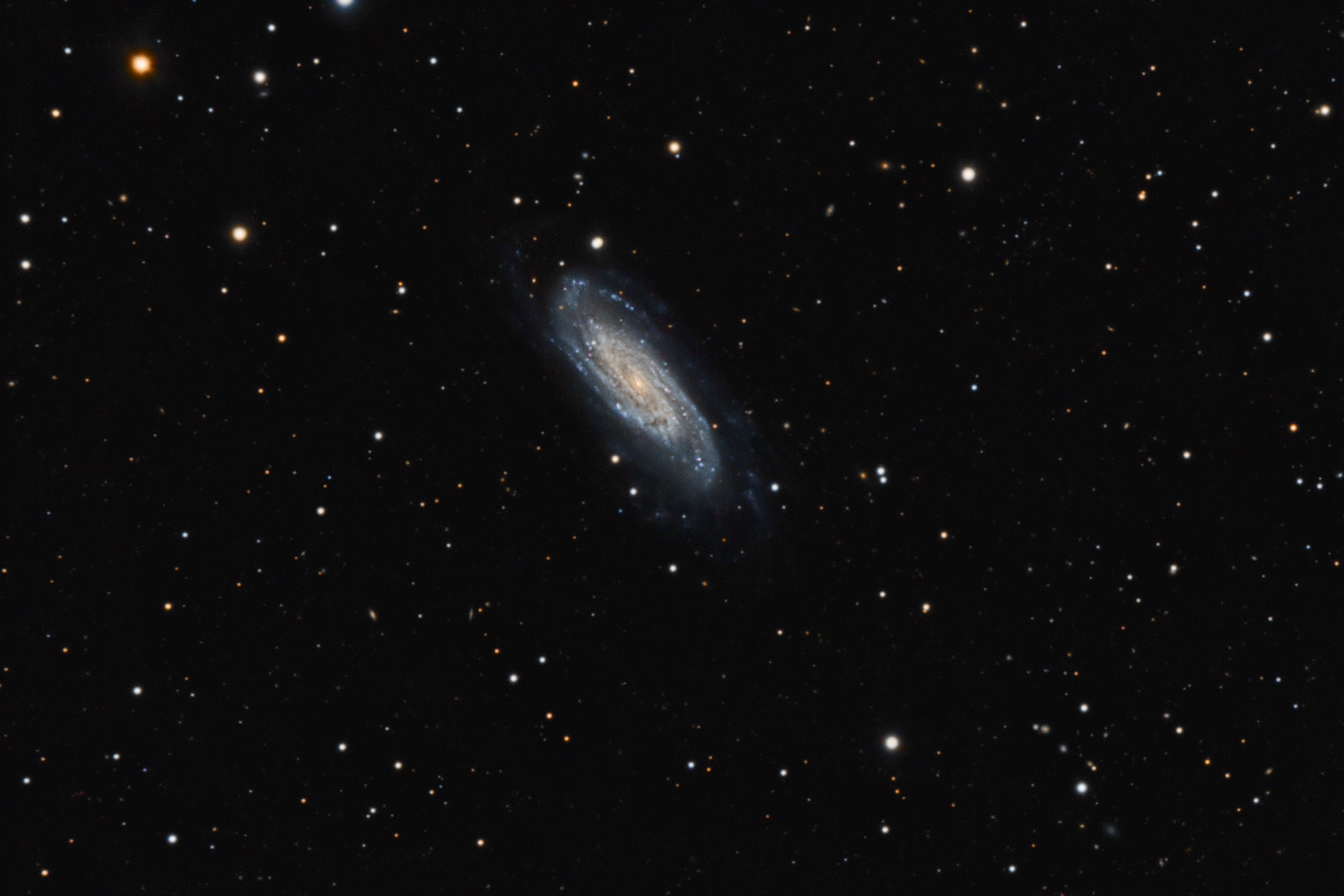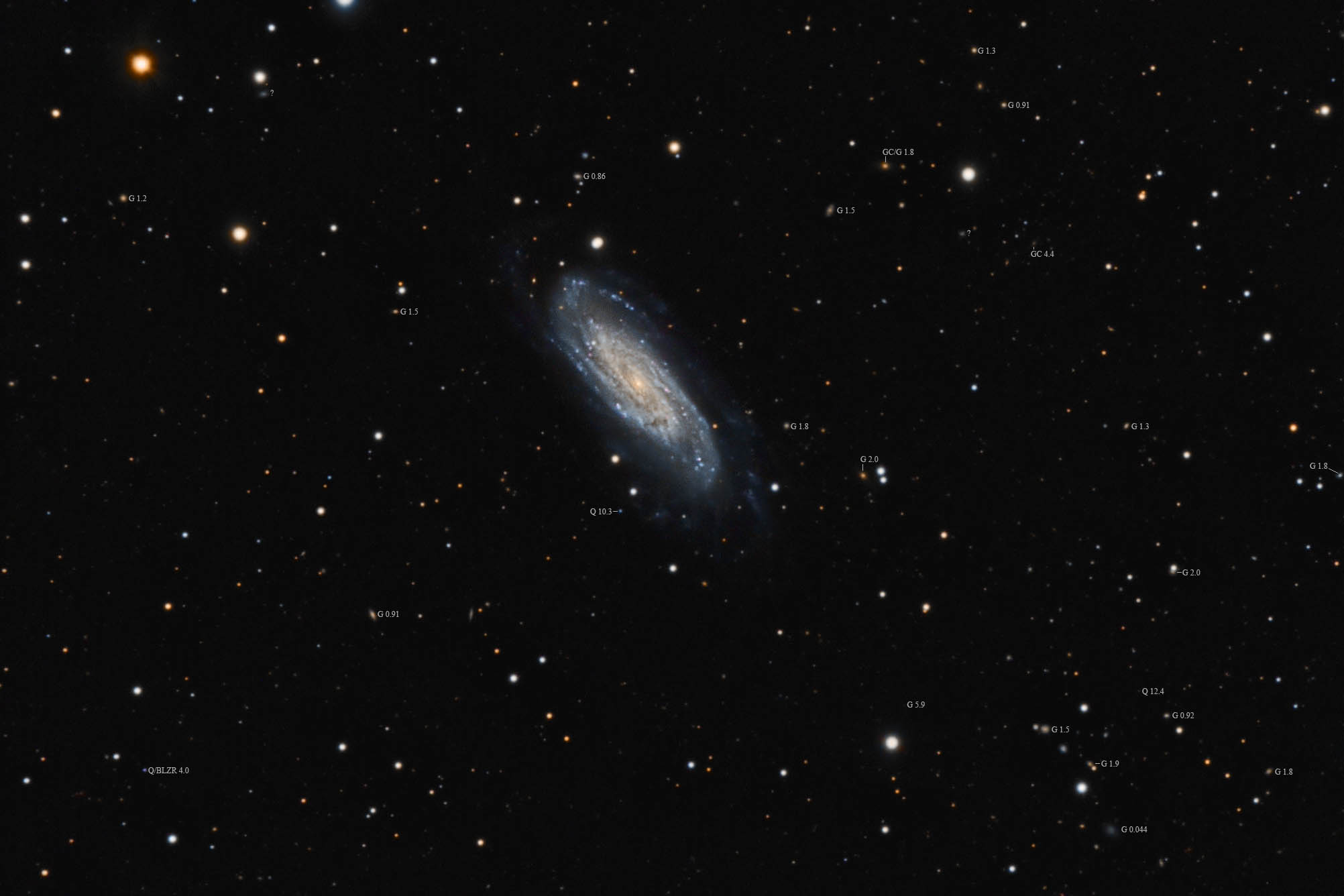Object name: NGC3198 NGC 3198 is a classic grand design spiral galaxy in southern Ursa Major near the western back foot. Recent Cepheid measurements by the HST put it at 47.3 million light-years from earth. The redshift would indicate 41 million light-years so there is some agreement. Though NED lists some 17 other Cepheid measurements from earth-based scope that give values from 36.5 to 57.4 million light-years. But their average comes back to 47 million light-years so I'll go with the HST project's determination. The HST image of part of the galaxy is at:
http://upload.wikimedia.org/wikipedia/commons/d/d2/NGC_3198_Hubble_WikiSky.jpg
I imaged this one just because I had never imaged it before and because I thought I spotted an interesting distant galaxy cluster in the POSS plates to the west-northwest of NGC 3198. It is the cluster WHL J101858.1+453618 listed at 4.4 billion light-years. It is marked by GC 4.4 in the annotated image. NED shows it containing 21 galaxies. Many of these appear to be visible in my image. The position seems to be that of the largest and brightest member though it is shown to have a distance of only 4.0 billion light-years. Though both are photographic estimates. These give a ballpark figure at best so the difference isn't all that surprising.
Due to wanting to try to pick up members of this cluster I doubled my normal luminosity time. Instead of my normal 22.5 limiting magnitude this one goes far deeper. The quasar southwest of the NGC 3198 at 12.4 billion light-years is listed at magnitude 23.2.
Down in the lower left corner is a Blazar (BLZR). These are quasars in which the relativistic jet is pointed right at us. This causes rapid fluctuations in brightness. This also makes it a BRLG. This stands for Bright Radio Line Galaxy as seen by radio telescopes. This is a rather nearby one so bright and earned 29 separate designations in NED! I'll use the first one, B3 1018+456. Enter that in NED to see the rest.
In the lower right corner is a small, very fuzzy blue blob of a galaxy. It has a redshift that puts it about the same distance as far large NGC 3198, only 44 million light-years away. It must be some sort of dwarf Magellanic galaxy. NED lists its largest diameter at 0.32 minutes which would give it a size of only 4100 light-years. NGC 3198's diameter is 8.5 minutes. At 47 million light-years that would give a diameter of 116,000 light-years, about the size of our galaxy.
Anyone following my posts knows I keep finding, usually blue, galaxies not listed in NED even though many far fainter ones are. This image will be no exception. Toward the upper left, below a rather bright, white, star is such a blue galaxy. As usual, it is marked with a question mark. I just scanned the annotated image for blue galaxies not listed. It was the first one I tried! That caused me to try some more. Next 4 were listed at NED, just without redshift data. That's fine. But then the next one was another miss. It too is below a rather white star, though well below it. Look to the northwest, left of the galaxy cluster at 4.4 billion light-years. I quit looking after that.
14" LX200R @ f/10, L=8x10' RGB=2x10'x3, STL-11000XM, Paramount ME Related Designation(s):2MASS J10195500+4532593, 2MASX J10195499+4532588, 2MASXi J1019549+453259, 2MIG 1421, AKARI J1019545+453302, ASK 209358.0, CGCG 1016.9+4549, CGCG 240-030, CXO J101954.9+453258, GALEXASC J101955.11+453258.9 , IRAS 10168+4548, IRAS F10168+4547, LDCE 0743 NED002, MCG +08-19-020, NGC 3198, NGC3198, NSA 036578, PGC 030197, SDSS J101954.92+453259.0, SDSS J101954.92+453259.1, SSTSL2 J101954.98+453259.4, UGC 05572, UZC J101954.9+453300, | | 
